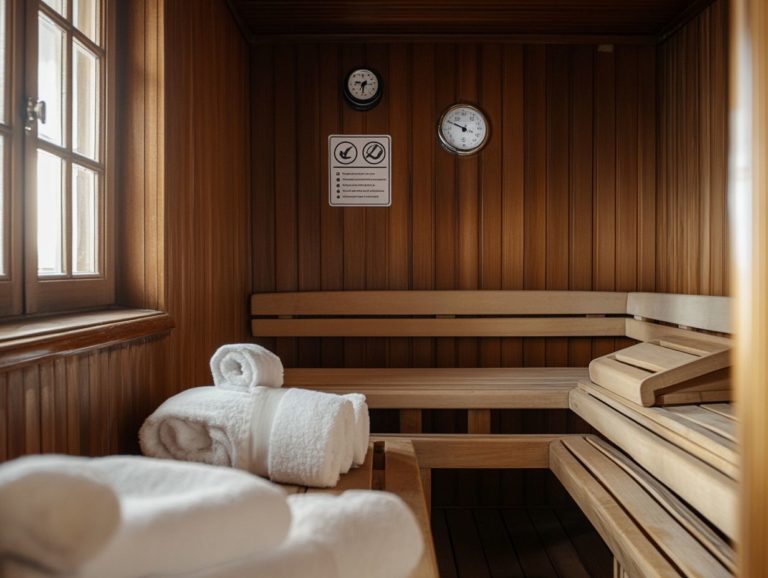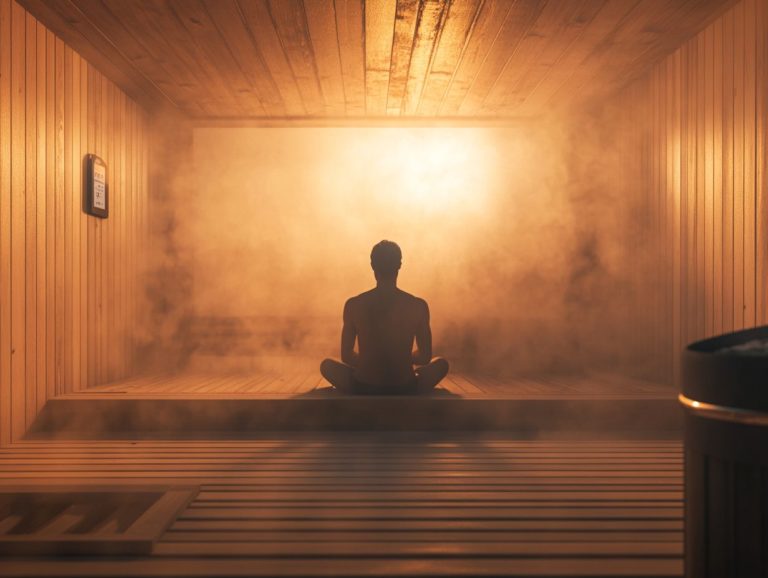How to Choose a Safe Sauna Environment
Saunas have long been revered for their relaxing and rejuvenating benefits. Knowing how to use them correctly is crucial for a safe and enjoyable experience. This is especially important considering the various sauna types available today.
This article delves into the different types of saunas, including traditional saunas, saunas that use infrared light, hybrid saunas, and steam saunas. Each type provides distinct advantages. We will also address vital safety considerations, such as temperature, humidity, and cleanliness, along with necessary precautions for individuals with specific health conditions.
Discover how to select a safe sauna environment by considering sauna location, size, and features. Your journey into relaxation will be enjoyable and worry-free!
Contents
- Key Takeaways:
- Understanding Saunas and Their Benefits
- Factors to Consider for Sauna Safety
- Precautions for Using a Sauna
- Choosing a Safe Sauna Environment
- Frequently Asked Questions
- What factors should I consider when choosing a safe sauna environment for stress relief and relaxation with benefits for cardiovascular health?
- What is the difference between a traditional sauna and an infrared sauna?
- What materials are safe for a sauna environment?
- How important is ventilation in a sauna?
- Are there any safety features I should look for in a sauna environment?
- Can children use a sauna safely?
Key Takeaways:
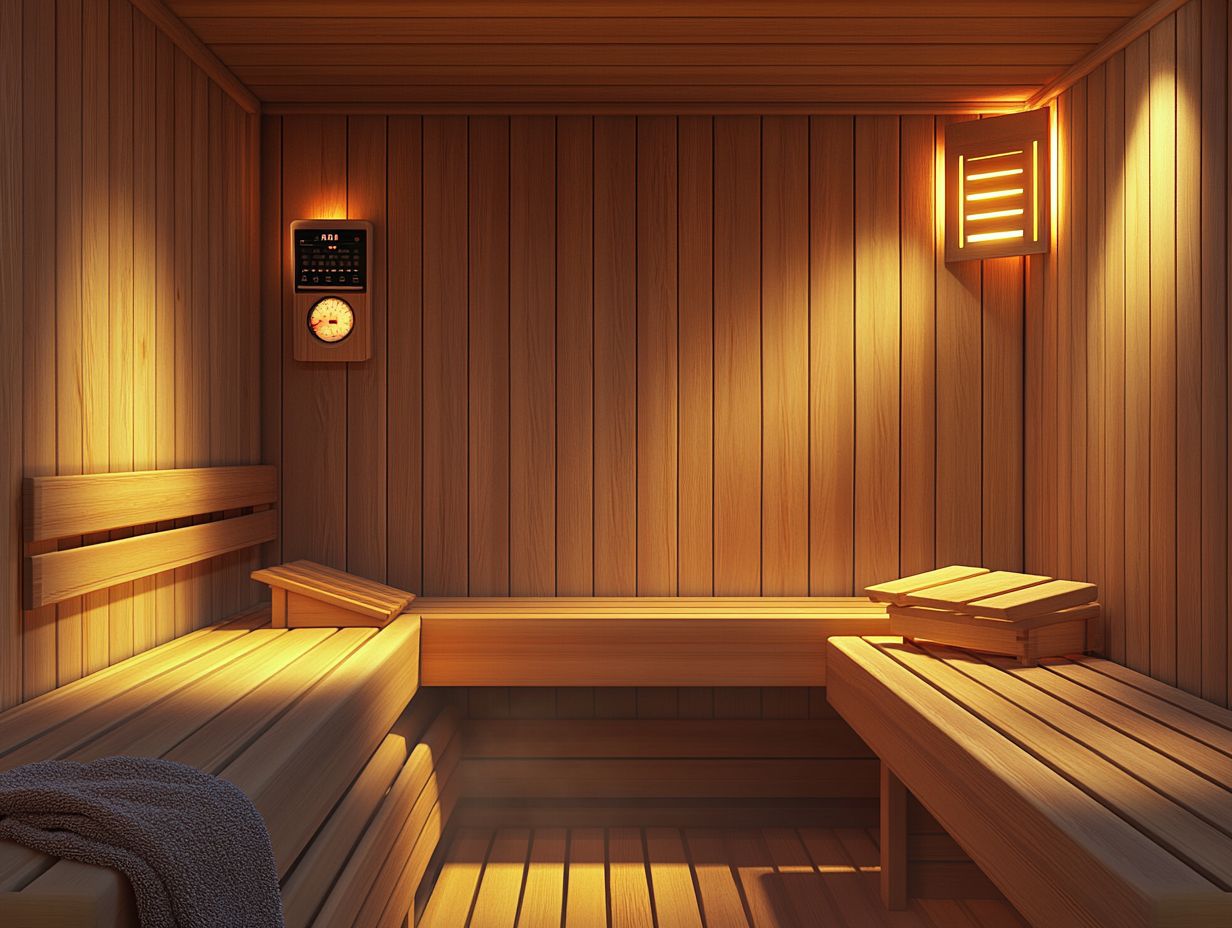
- Choose a sauna that maintains proper temperature and humidity levels for a safe experience.
- Prioritize cleanliness and maintenance when selecting a sauna, as a well-maintained facility can reduce health risks.
- Consider your health conditions, such as heart disease, and ensure proper hydration and rest before and after using a sauna to prevent potential negative effects.
Understanding Saunas and Their Benefits
Understanding saunas and their myriad benefits including stress relief and improved circulation is essential for anyone keen on wellness practices. Saunas, whether traditional, using infrared light, or steam, have captured attention for their impressive health perks, such as enhanced circulation, detoxification, and skin rejuvenation.
Engaging in these heat therapy methods during sauna sessions not only promotes relaxation but also contributes to glowing skin. This makes saunas a favorite among enthusiasts around the globe.
Types of Saunas and Their Benefits
You ll discover a variety of sauna types, each presenting unique benefits tailored to your preferences and wellness aspirations.
For example, traditional saunas utilize a heated stone stove to radiate warmth, creating a soothing environment that enhances circulation and promotes relaxation. If you prefer a gentler experience, saunas that use infrared light work at lower temperatures while effectively facilitating weight loss and alleviating muscle pain through innovative technology.
If you seek versatility, hybrid saunas combine features of different sauna types, while steam saunas provide a humid atmosphere that can be particularly beneficial for respiratory relief and overall wellness. The convenience of portable saunas allows you to prioritize your health and well-being, even without a dedicated space.
Each type presents a distinctive experience that can significantly elevate your overall wellness journey.
Factors to Consider for Sauna Safety
Ensuring sauna safety is crucial for enhancing your sauna experience. A variety of factors can impact your comfort and health. When considering sauna safety, it’s vital to monitor temperature and humidity levels, as they play a significant role in your overall well-being.
Proper installation and maintenance of the sauna, along with strict adherence to electrical requirements, insulation, and sauna maintenance guidelines, will further enhance the safety and enjoyment of your sauna environment.
Ready to experience the benefits of a sauna? Find your perfect sauna today!
Temperature and Humidity Levels
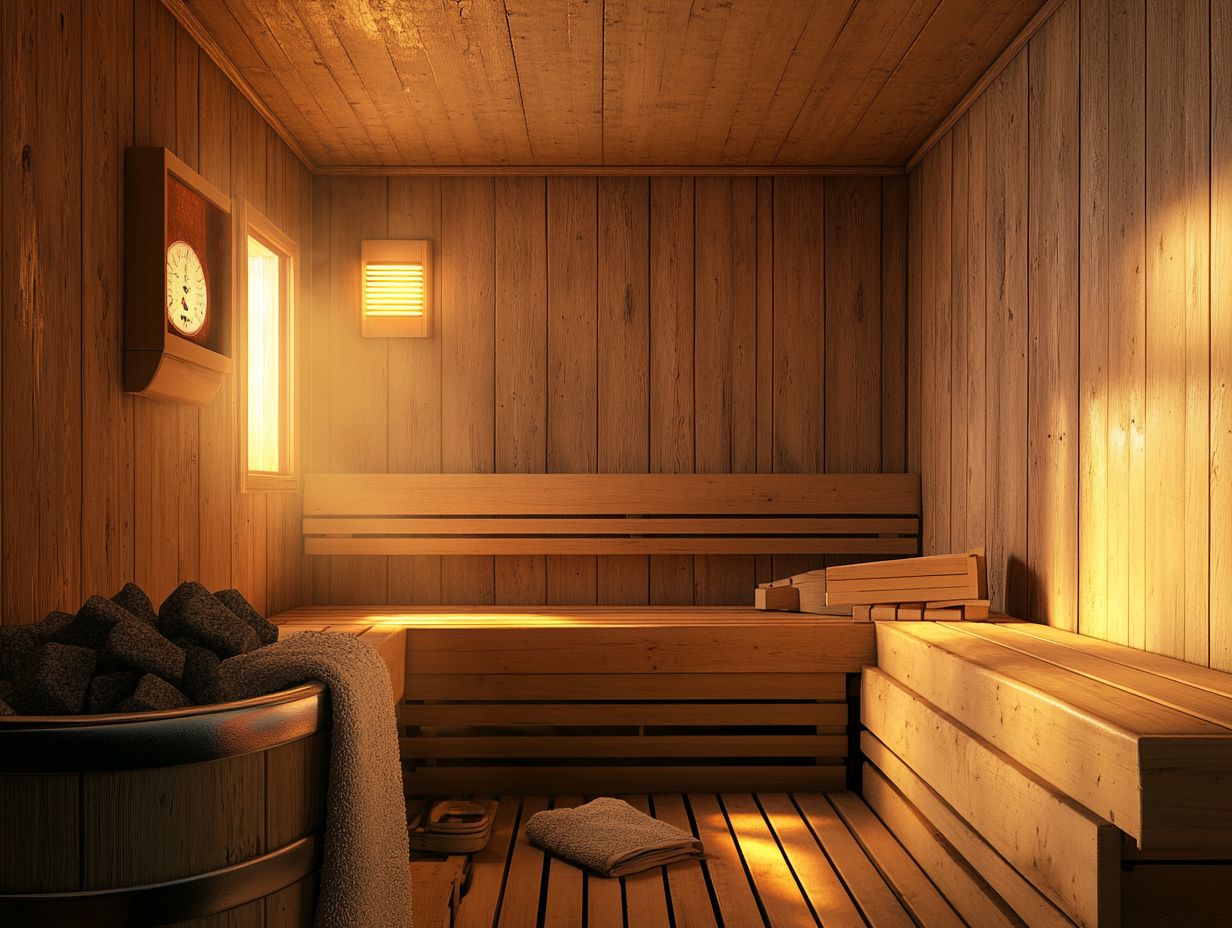
Temperature and humidity levels are vital elements that significantly influence your sauna experience and the overall health benefits you can enjoy. Typically, the ideal temperature range for traditional saunas hovers around 150 F to 195 F.
Infrared saunas tend to operate at lower temperatures, allowing you to enjoy the perks of heat therapy, which is using heat to soothe muscles and improve well-being, without feeling overwhelmed.
Keeping the right humidity levels is equally important. Proper humidity can enhance sweat production, making your sauna session more effective.
In a traditional sauna, humidity levels are generally maintained between 10% and 20%. You can easily adjust these levels by pouring water over heated stones, creating steam that enriches the atmosphere and helps moisturize your skin.
On the other hand, infrared saunas usually benefit from lower humidity, allowing the heat to penetrate more deeply and ensuring a comfortable environment.
Utilizing devices that measure humidity and following humidity control tips will help you monitor both temperature and humidity with precision.
Pay attention to how your body feels for the best sauna experience. Beginning with shorter sessions and gradually increasing the duration can lead to a more enjoyable and beneficial sauna experience, tailored to your unique comfort and tolerance.
Cleanliness and Maintenance
Regular cleanliness and maintenance of saunas are paramount for ensuring a safe and enjoyable experience for you and other users. Keeping your sauna pristine not only extends its lifespan but also fosters a healthy environment.
This helps prevent the accumulation of harmful toxins and ensures effective sauna maintenance. By employing the right sauna accessories and features, such as insulation and humidity control systems, you can further enhance cleanliness and overall performance.
To achieve this, establish a consistent cleaning schedule. This should include sanitizing the benches, walls, and floors with non-toxic, sauna-safe cleaners.
Utilizing sauna accessories for optimal hygiene, such as regularly replacing or washing your sauna towels, minimizes the spread of bacteria and keeps the space feeling fresh. Investing in high-quality accessories, like moisture-absorbing mats, can effectively control water accumulation and odors.
Proper air circulation is vital. It improves the sauna s efficiency and elevates the overall atmosphere, making each session more enjoyable while promoting optimal hygiene.
Precautions for Using a Sauna
Taking precautions when using a sauna is crucial for maximizing health benefits while minimizing the risks linked to heat exposure. Carefully evaluate any pre-existing health conditions, such as heart disease or other cardiovascular issues, as these can influence your tolerance during sauna sessions.
Maintaining proper hydration before, during, and after your time in the sauna is essential to prevent dehydration and ensure a safe and enjoyable experience. For more detailed information, check out sauna safety: the link between comfort and safety.
Health Conditions to Consider
Certain health conditions require your careful consideration before stepping into a sauna, as they may introduce risks you want to avoid. For example, if you have heart disease or respiratory issues, consult a healthcare professional before indulging in sauna sessions.
The high temperatures can elevate your heart rate and strain your cardiovascular system. Awareness of these conditions is essential for enjoying a safe sauna experience.
If you struggle with skin conditions like eczema or psoriasis, the heat may worsen your symptoms. Tailored advice from a dermatologist can be invaluable.
If you have diabetes, monitoring your blood sugar levels is crucial, as sauna heat can lead to unexpected fluctuations.
To ensure a safer experience, hydrate well both before and after your sauna sessions. Consider limiting your time in the sauna to prevent overheating and manage your body temperature effectively. Tuning in to your body’s signals and prioritizing your health are key strategies for enjoying the therapeutic benefits of a sauna without compromising your well-being. For more insights, check out sauna safety: key takeaways for users.
Proper Hydration and Rest
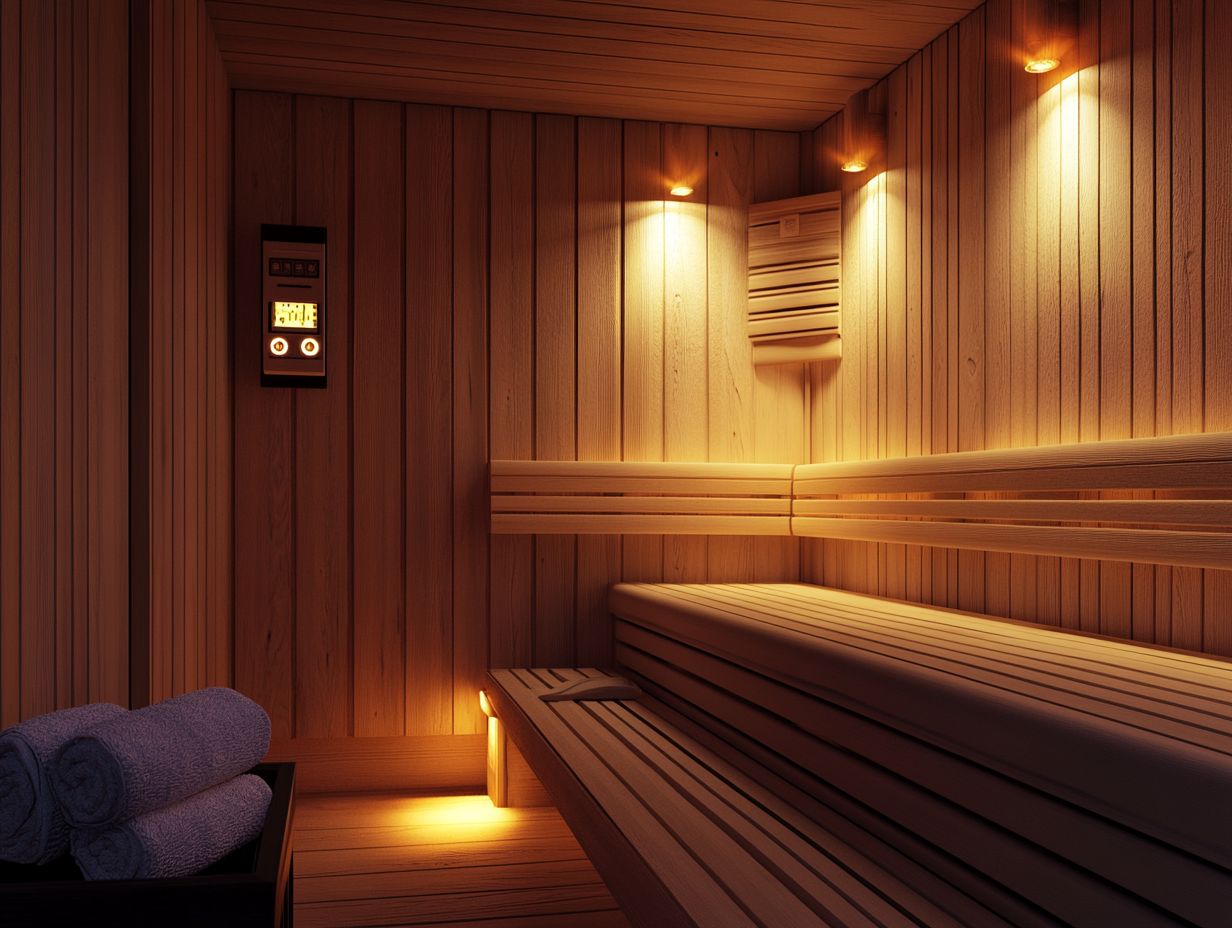
Proper hydration and rest are essential for elevating your sauna experience and promoting your overall well-being. Before you step into the sauna, make it a point to drink plenty of water. This simple act counters the fluid loss that comes with increased sweating.
This proactive approach is key to preventing dehydration, which can mute the invigorating effects of the heat, especially when using a portable home sauna or any sauna design. Keep a water bottle close at hand as a gentle reminder to sip throughout your session.
Once you emerge from the sauna, allow yourself a few moments of quiet rest. This helps your body stabilize and return to a normal temperature, minimizing any potential discomfort. Treat yourself to electrolyte-rich drinks or add essential oils for aromatherapy to replace lost minerals and enhance your recovery.
By prioritizing hydration and giving yourself time to rest after your session, you can significantly elevate your enjoyment and fully embrace the benefits of sauna therapy. Don’t miss out on the rewards of proper hydration and rest!
Choosing a Safe Sauna Environment
Selecting a safe sauna environment is crucial for ensuring that your experience is both positive and health-affirming. When considering a sauna facility, it s wise to research your options thoroughly. Pay special attention to cleanliness, features, and amenities such as sauna materials and heating options that enhance both comfort and safety.
Taking the time to visit the facility beforehand allows you to gauge the overall atmosphere and the level of care invested in maintaining the sauna area. This ensures that you make an informed choice by understanding the sauna safety policies for your well-being.
Researching and Visiting Sauna Facilities
Researching and visiting sauna facilities is crucial for ensuring a safe and enjoyable experience. Seek out places that prioritize hygiene and maintenance. Look for those that offer a variety of features and sauna accessories to enhance your comfort.
Check if the sauna has proper ventilation, temperature controls, and amenities like towels, showers, and waiting areas. These details can significantly improve your overall experience. Safety measures are also important, so look for clear usage instructions and staff trained in emergency protocols and first aid. Additionally, consider how to choose safe sauna accessories to enhance your safety and comfort.
When you’re sifting through reviews, pay close attention to specific comments about cleanliness and the friendliness of the staff and sauna enthusiasts. Positive feedback regarding comfort and safety measures often signals a reliable spot for relaxation.
By prioritizing safety and comfort, you ll set yourself up for a truly satisfying and rejuvenating sauna experience, enjoying health benefits like improved circulation and skin health from regular sauna use.
Questions to Ask Staff and Observations to Make
Asking the right questions and making careful observations can elevate your sauna experience while ensuring your safety. When engaging with the staff at a sauna facility, inquire about their maintenance protocols, cleanliness standards, and the various heating options, including traditional saunas, Finnish saunas, and infrared technology.
Observe the overall environment, including the condition of the sauna and the features available. This will provide valuable insights into the facility s commitment to your safety and comfort.
Consider posing specific questions such as:
- How often is the sauna cleaned and maintained?
- What safety measures are in place for emergency situations?
- Are the staff trained in first aid and spa etiquette?
Monitor key observations like the freshness of the air quality, the condition of the wooden benches, and whether safety signage and sauna guidelines are prominently displayed. For additional insights, consider tips for buying a safe home sauna. These details reveal a lot about the facility’s reliability and dedication to visitor well-being, enabling you to make informed choices about where to relax and rejuvenate.
Frequently Asked Questions
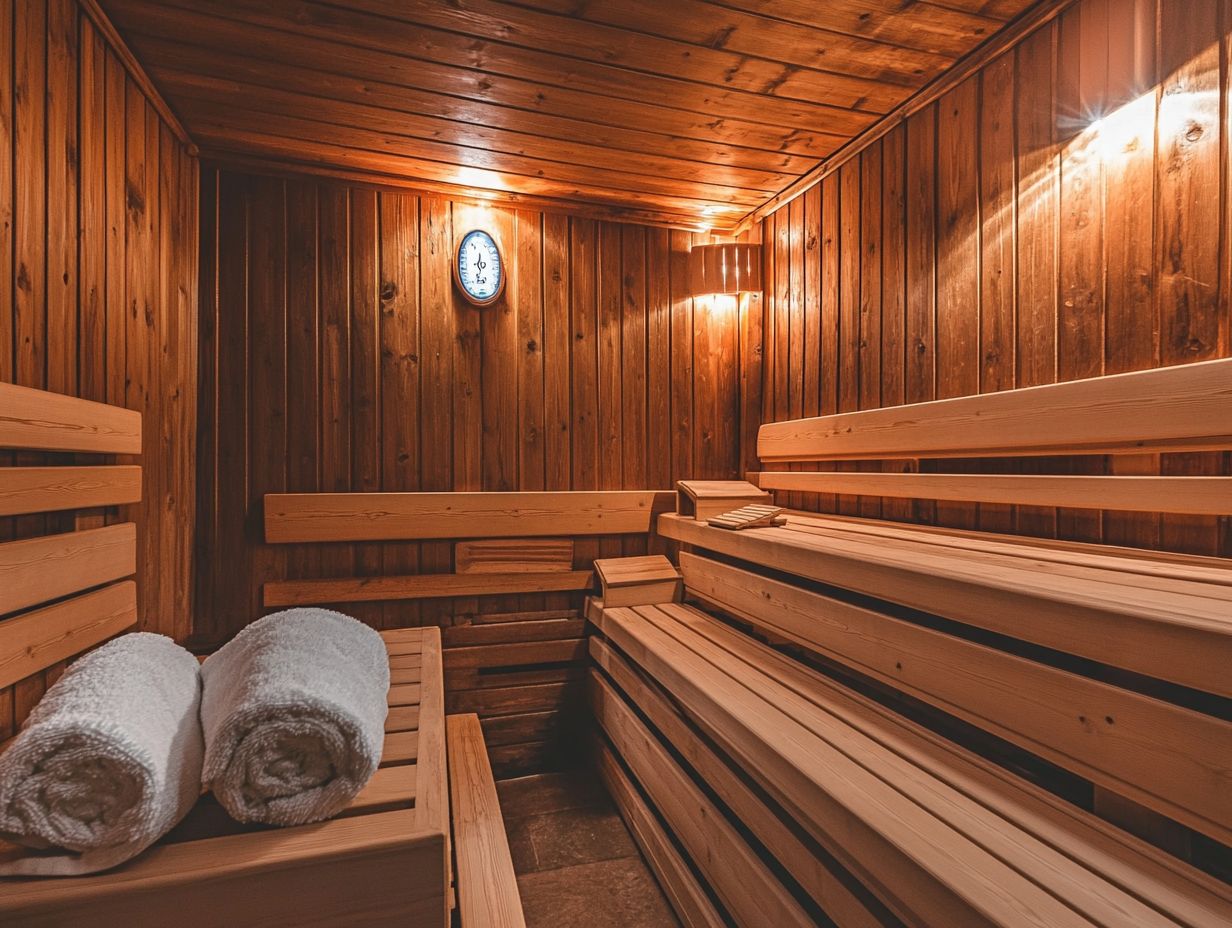
What factors should I consider when choosing a safe sauna environment for stress relief and relaxation with benefits for cardiovascular health?
When choosing a safe sauna environment, consider the type of sauna, including steam and hybrid options (traditional or infrared). Think about the materials used, such as cedar, spruce, or pine, as well as ventilation and safety features like emergency shut-off buttons and slip-resistant floors.
What is the difference between a traditional sauna and an infrared sauna?
A traditional sauna uses heated rocks or a stove to create high temperatures. In contrast, an infrared sauna uses light to heat your body directly, offering a different experience. Both can be safe options, but it’s crucial to consider your personal preferences and health conditions, like heart disease, before choosing one.
What materials are safe for a sauna environment?
The safest materials for a sauna are non-toxic and heat-resistant, such as cedar or hemlock wood, stainless steel, and ceramic tiles. Avoid materials that may emit harmful fumes when heated, like plastic or particle board.
How important is ventilation in a sauna?
Proper ventilation is essential in a sauna. It helps ensure the air isn’t too hot and humid, which can lead to breathing difficulties and heat stroke. Look for saunas with vents that can be opened and closed to regulate temperature and humidity.
Are there any safety features I should look for in a sauna environment?
Yes! Don’t skip these essential safety features: emergency shut-off buttons, slip-resistant floors, and temperature controls. It’s also smart to have a timer to limit your sauna time and avoid dehydration.
Can children use a sauna safely?
Children should only use a sauna under adult supervision and for a limited time. For kids under 12, it’s best to skip the sauna for safety!



